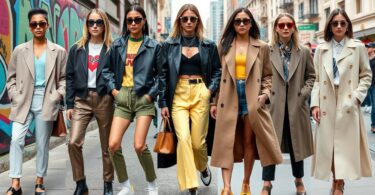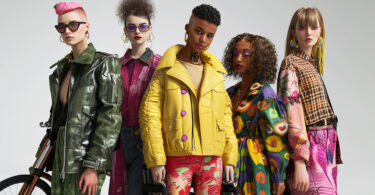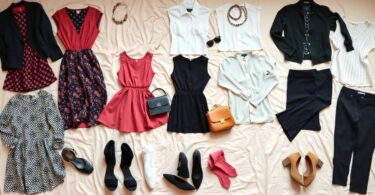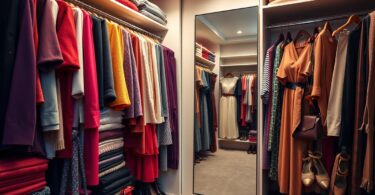The modern fashionista balances chic aesthetics with planetary stewardship, navigating the world of Sustainable Fashion with finesse and an eco-conscious mind. Embracing Stylish and Eco-Friendly attire is not only about making Green Wardrobe Choices, but it’s an act of expressing a responsible lifestyle. This journey begins with an exploration of textiles that tread lightly on the earth and ends with a closet that is both fashionable and kind to our environment.
Key Takeaways
- Discover Sustainable Fashion options that align with your style.
- Embrace Green Wardrobe Choices without compromising on elegance.
- Learn how to make eco-friendly choices a staple in your fashion repertoire.
- Understand that being Stylish and Eco-Friendly goes hand in hand.
- Find out how to identify and select materials that reduce environmental impact.
- Adopt a conscious approach to your wardrobe and inspire change.
Embracing Sustainable Fashion for a Greener Wardrobe

In the quest for a more sustainable lifestyle, clothing plays a pivotal role. When you choose eco-friendly apparel, you not only enhance your wardrobe but also contribute positively to the environment. This section explores how sustainable materials, ethical fashion brands, and the avoidance of greenwashing can revolutionize your fashion choices for the better.
Understanding the Importance of Sustainable Materials
Sustainable materials are at the heart of eco-friendly apparel. These fabrics, such as organic cotton, bamboo, and recycled polyester, require less water and energy to produce and reduce waste, making them ideal for anyone looking to cultivate a green wardrobe. Their benefits extend beyond environmental impact, often delivering durability and comfort without compromising style.
Top Brands Promoting Eco-Friendly Apparel
Several ethical fashion brands have stepped up to the challenge of providing stylish and sustainable clothing options. These pioneers prioritize transparent supply chains, fair labor practices, and the use of environmentally friendly materials. Brands like Patagonia, Stella McCartney, and Eileen Fisher show that you can wear the latest trends and be conscientious about the health of the planet.
How to Spot and Avoid Greenwashing in Fashion
While many brands genuinely strive to be sustainable, others indulge in greenwashing—misleading consumers about the environmental benefits of their products. To avoid falling prey to such practices, look for certifications like Global Organic Textile Standard (GOTS) and Fair Trade, and research brands’ environmental policies and practices before making a purchase. These steps ensure that your fashion choices align with genuine sustainability efforts.
Incorporating Recycled Fashion Into Your Style
Embracing recycled fashion is more than just a trend—it’s a movement towards building a greener and more sustainable society. By integrating second-hand fashion finds into your wardrobe, you can achieve a unique style while contributing to environmental conservation. This section explores various facets of recycled clothing and how you can incorporate them seamlessly into your daily fashion choices.
Finding Quality Second-hand Clothes
Finding quality second-hand garments is crucial in upholding style standards while supporting recycled fashion. Thrift stores, vintage boutiques, and online platforms are treasure troves for discovering unique pieces. Remember, second-hand doesn’t mean second best. It represents an opportunity to unearth fashion that tells a story, ensuring you stand out from the mass-produced crowd.
Upcycling: Giving Old Outfits New Life
Upcycling clothing involves transforming old or unused garments into something new and exciting. This creative process not only gives a personal touch to your wardrobe but also reduces waste significantly. Whether it’s turning old jeans into chic tote bags or adding new embellishments to a vintage jacket, upcycling is all about letting your creativity flow.
The Role of Thrift Shopping in Eco-Conscious Styling
Thrift shopping benefits extend beyond the individual. They ripple out to the environment and the community. By choosing thrifted items, you reduce demand for new resources and help cut down on manufacturing impacts. Moreover, thrift shopping can be a delightful exploration, where each visit brings a chance for new discoveries, fostering a more thoughtful and sustainable fashion sense.
Stylish and Eco-Friendly: Crafting a Conscious Look
In today’s fashion industry, the integration of Conscious Consumerism, Eco-Friendly Fashion, and Style with Sustainability is more than a trend—it’s a necessity for those looking to make a positive impact on the environment while staying stylish. This approach is not only about reducing the ecological footprint but also about showcasing a commitment to ethics and aesthetics.

Creating a wardrobe that reflects Style with Sustainability doesn’t require sacrificing your personal style. By choosing pieces made with recycled materials, supporting brands that are transparent about their manufacturing processes, and prioritizing durability over disposability, you can craft outfits that both look good and do good.
For instance, integrating basic pieces like organic cotton T-shirts and hemp-based accessories can significantly elevate your style quotient while adhering to Eco-Friendly Fashion principles. Additionally, opting for local artisans and smaller fashion labels that use ethically sourced materials can help boost the economy and reduce environmental impact.
To truly embrace Conscious Consumerism, one must be willing to invest time and effort into researching brands and materials that are committed to sustainability. It’s about making informed choices that align with your values.
Moreover, Style with Sustainability isn’t just about the clothes we wear but also about the lifestyle we lead. Choosing eco-friendly accessories, like biodegradable phone cases and sunglasses made from recycled plastics, can further refine your style while emphasizing your commitment to sustainability.
This holistic approach to fashion ensures that your style is not only current but also conscious and considerate, making a statement that extends beyond the mere aesthetic to reflect deeper values of stewardship and responsibility.
Create a Personalized Wardrobe with Customized Denim Jackets
Embracing the ethos of Eco-Friendly Fashion Customization allows for a striking expression of personal style while contributing positively to the environment. Customized Denim Jackets have emerged as a canvas for creativity and a statement of individuality. By engaging in Sustainable DIY Fashion, enthusiasts not only carve out their distinct style but also uphold the principles of sustainability.
The allure of denim jackets as a medium for artistic expression lies in their versatility and durability. Transforming a simple denim jacket into a piece of wearable art showcases not only creativity but also a commitment to reducing fashion waste.
DIY Denim Decoration Ideas
Innovative decoration methods have rooted themselves deeply within DIY communities. Embroidery, fabric paint, and patchwork, utilizing scraps from discarded textiles, are popular techniques that promote Eco-Friendly Fashion Customization. These sustainable practices not only enhance the aesthetic appeal of denim but also prolong the life cycle of the material.
Merging Art and Fashion Sustainably
The intersection of art and fashion opens up new possibilities for sustainable design. By using eco-friendly materials and dyes, fashion enthusiasts can create Customized Denim Jackets that are both stylish and environmentally conscious. This synthesis of art and sustainability is at the core of transforming fashion into a form of environmental activism.
Denim Jacket Workshops and Eco-Friendly Paints
To further this artistic venture, numerous workshops offer classes on how to personalize denim using eco-friendly paints and techniques. These gatherings are not just about creating a unique piece of clothing but also about education and community building around Sustainable DIY Fashion. Such initiatives cultivate a culture of sustainability and creativity, inspiring participants to reimagine fashion in eco-friendly ways.
By adopting these practices, individuals can take significant strides towards a more sustainable wardrobe while fostering a sense of community and shared purpose in the realm of fashion. Customized Denim Jackets serve not only as a fashion statement but as a testament to the possibilities inherent in combining sustainability with personal style.
Diversity in Sustainability: Trend Fashion Plus Size Models Names You Should Know
The intersection of trend fashion and sustainable fashion diversity is beautifully illustrated by trail-blazing plus size models who advocate for eco-friendly practices within the fashion industry. These models not only challenge traditional beauty standards but also promote a more inclusive vision of fashion that encourages sustainability.
Significant strides have been made by plus size models who utilize their platforms to endorse and influence trend fashion while ensuring an ethical approach to production and design. These advocates highlight how sustainable fashion diversity encompasses an array of body types, promoting an inclusive environment where everyone can participate in and benefit from sustainable practices.
The growing influence of plus size models in the sustainable fashion sector underlines the importance of diversity and representation. This shift towards inclusive fashion not only broadens the market but also enriches the industry by including varied perspectives and insights, which are critical for the evolution and acceptance of sustainable fashion practices globally.
As the fashion industry continues to evolve, recognizing and celebrating the role of plus size models in promoting trend fashion will be critical. Their commitment to environmental stewardship and their challenge to conventional norms pave the way for a more diverse and sustainable fashion future.
Tips for Maintaining Your Eco-Friendly Fashion Pieces
Maintaining the quality and appearance of your wardrobe while adhering to eco-friendly laundry practices is pivotal in promoting long-lasting fashion. To achieve this, it is essential to adopt sustainable clothing care techniques that are gentle on fabrics and the environment.
Firstly, consider using cold water for washing your garments. This simple switch not only saves energy but also minimizes the fiber damage that hot water can cause, thus extending the lifespan of your clothes. Additionally, opting for environmentally friendly detergents can significantly reduce the chemicals released into the ecosystem during your laundry routine.
To further embrace sustainable clothing care, drying your clothes naturally is a commendable option. Air-drying not only preserves the integrity of the fabric but also cuts down on energy usage associated with electric dryers. For those living in compact spaces, using an indoor drying rack can be just as effective.
In cases where garments start to show signs of wear, rather than disposing of them, consider mending or upcycling them into new, fashionable pieces. This approach not only contributes to long-lasting fashion but also reduces textile waste.
For delicate or high-value items, hand washing can preserve the fabric better and avoid mishaps typically caused by machine washing. It’s a small yet impactful part of eco-friendly laundry practices that can make a significant difference.
Ultimately, integrating these practices into your daily routine encourages a sustainable lifestyle and promotes the longevity of your fashion pieces. By carefully choosing how you care for your clothes, you are not only investing in their durability but also contributing to a more sustainable planet.
Joining the Movement: How to Become a Sustainable Fashion Advocate
Embracing an Eco-Friendly Lifestyle goes beyond personal choices and extends to influencing the community and industry at large. To effectively join and bolster the Sustainable Fashion Movement, transforming into an advocate isn’t just beneficial—it’s transformative. Advocacy in fashion does not require a soapbox; it begins with conscious decisions like choosing to purchase from ethical brands that are committed to environmental responsibility. Beyond individual purchasing power, leveraging platforms to educate and inspire others can create ripples that evolve into waves of change. By effectively combining fashion advocacy with action, each person becomes a beacon for sustainable practices, reshaping the fashion landscape.
Strides in the Sustainable Fashion Movement have proven that collective action can dramatically shape the industry’s trajectory. Fashion Advocacy can manifest through several practical steps: hosting clothing swap events, organizing talks, or attending conferences centered on sustainability. Through these efforts, community engagement becomes a potent tool for spreading the ethos of an Eco-Friendly Lifestyle. Adopting habits such as supporting local artisans and designers who prioritize eco-conscious materials and production processes not only nurtures the local economy but also upholds principles that favor the planet.
Ultimately, the power of Fashion Advocacy lies in persistent, vocal support for a world where sustainability and style are not mutually exclusive but are intimately linked. Social media platforms offer an unprecedented opportunity to advocate for change, from highlighting the consequences of fast fashion to celebrating the achievements of those who champion eco-responsibility. By amplifying the success stories of sustainable brands and encouraging transparency in the fashion industry, advocates can play a critical role in steering consumer behavior towards a future where fashion is not just about looking good, but also about doing good for the world.







